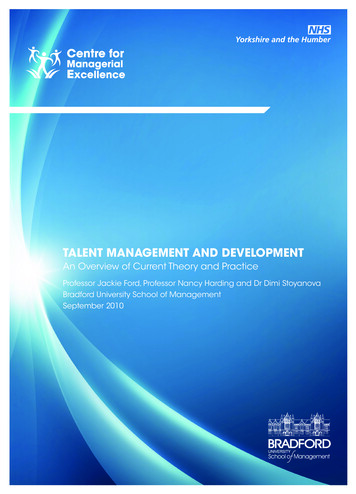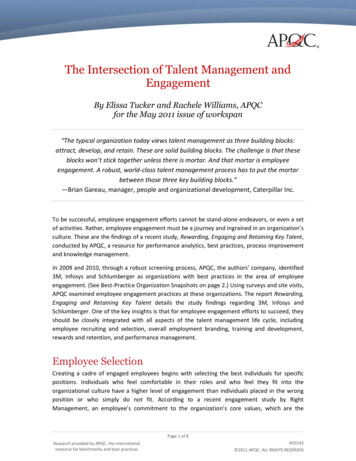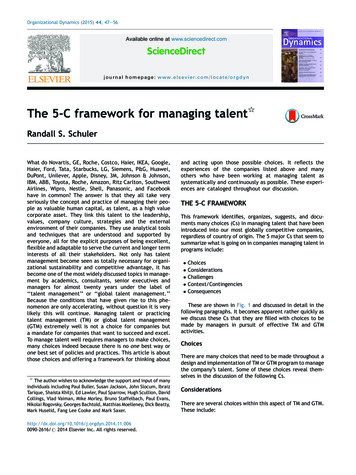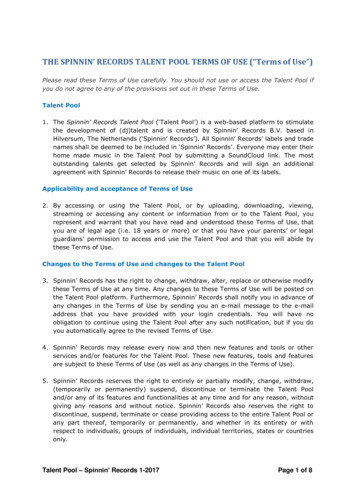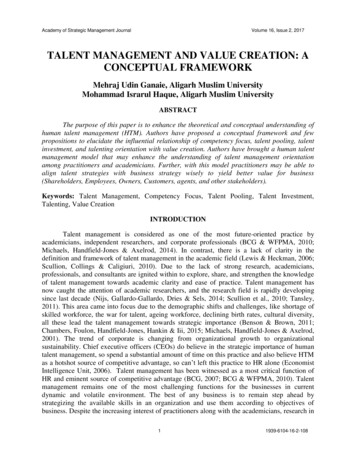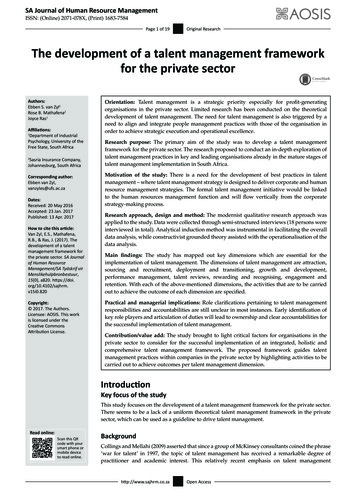
Transcription
SA Journal of Human Resource ManagementISSN: (Online) 2071-078X, (Print) 1683-7584Page 1 of 19Original ResearchThe development of a talent management frameworkfor the private sectorAuthors:Ebben S. van Zyl1Rose B. Mathafena2Joyce Ras1Affiliations:1Department of IndustrialPsychology, University of theFree State, South AfricaSasria Insurance Company,Johannesburg, South Africa2Corresponding author:Ebben van Zyl,vanzyles@ufs.ac.zaDates:Received: 20 May 2016Accepted: 23 Jan. 2017Published: 13 Apr. 2017How to cite this article:Van Zyl, E.S., Mathafena,R.B., & Ras, J. (2017). Thedevelopment of a talentmanagement framework forthe private sector. SA Journalof Human ResourceManagement/SA Tydskrif virMenslikehulpbronbestuur,15(0), a820. https://doi.org/10.4102/sajhrm.v15i0.820Copyright: 2017. The Authors.Licensee: AOSIS. This workis licensed under theCreative CommonsAttribution License.Orientation: Talent management is a strategic priority especially for profit-generatingorganisations in the private sector. Limited research has been conducted on the theoreticaldevelopment of talent management. The need for talent management is also triggered by aneed to align and integrate people management practices with those of the organisation inorder to achieve strategic execution and operational excellence.Research purpose: The primary aim of the study was to develop a talent managementframework for the private sector. The research proposed to conduct an in-depth exploration oftalent management practices in key and leading organisations already in the mature stages oftalent management implementation in South Africa.Motivation of the study: There is a need for the development of best practices in talentmanagement – where talent management strategy is designed to deliver corporate and humanresource management strategies. The formal talent management initiative would be linkedto the human resources management function and will flow vertically from the corporatestrategy-making process.Research approach, design and method: The modernist qualitative research approach wasapplied to the study. Data were collected through semi-structured interviews (18 persons wereinterviewed in total). Analytical induction method was instrumental in facilitating the overalldata analysis, while constructivist grounded theory assisted with the operationalisation of thedata analysis.Main findings: The study has mapped out key dimensions which are essential for theimplementation of talent management. The dimensions of talent management are attraction,sourcing and recruitment, deployment and transitioning, growth and development,performance management, talent reviews, rewarding and recognising, engagement andretention. With each of the above-mentioned dimensions, the activities that are to be carriedout to achieve the outcome of each dimension are specified.Practical and managerial implications: Role clarifications pertaining to talent managementresponsibilities and accountabilities are still unclear in most instances. Early identification ofkey role players and articulation of duties will lead to ownership and clear accountabilities forthe successful implementation of talent management.Contribution/value add: The study brought to light critical factors for organisations in theprivate sector to consider for the successful implementation of an integrated, holistic andcomprehensive talent management framework. The proposed framework guides talentmanagement practices within companies in the private sector by highlighting activities to becarried out to achieve outcomes per talent management dimension.IntroductionKey focus of the studyThis study focuses on the development of a talent management framework for the private sector.There seems to be a lack of a uniform theoretical talent management framework in the privatesector, which can be used as a guideline to drive talent management.Read online:Scan this QRcode with yoursmart phone ormobile deviceto read online.BackgroundCollings and Mellahi (2009) asserted that since a group of McKinsey consultants coined the phrase‘war for talent’ in 1997, the topic of talent management has received a remarkable degree ofpractitioner and academic interest. This relatively recent emphasis on talent managementhttp://www.sajhrm.co.zaOpen Access
Page 2 of 19represents a paradigm shift from more traditional humanresource to strategic talent management, which according toSilzer and Dowell (2009) is driven by corporate strategy,incorporated with other processes, managed as a corebusiness practice and deep-seated as a talent mindset. TheChartered Institute of Personnel and Development (2006)further views excellent and best practice level of talentmanagement as a strategy designed to deliver corporate andhuman resource management strategies. Often there is aformal talent management initiative linked to the humanresources management function and flowing vertically fromthe corporate strategy-making process.According to Powell and Lubitsh (2007), talent managementhas moved rapidly up the corporate agenda in recent years,and this is evident in the amount of research papers publishedover the last decade (e.g. Ashton & Morton, 2005; Bersin,2006; Chikumbi, 2011; Church, Rotolo, Ginther & Levine,2015; Collings, 2014; Festing & Shafer, 2014; Nijs, GallardoGallardo, Dries & Sels, 2014; Meyer, 2005; Odierno, 2015;Prinsloo, 2012). Egerova (2014) is of the opinion that theincreasing attention to talent is affected by factors includingglobalisation, knowledge-based competition, changing theworld of work as well as new forms of organisations anddemographic changes.Despite the growing popularity of talent management andover a decade of debate and hype, the concept of talentmanagement remains unclear (Collings & Mellahi, 2009;Festing & Schafer, 2014; Nijs et al. 2014). Furthermore, thecurrent state of talent management literature is exacerbatedby the fact that in addition to ambiguities around thedefinition of the concept, there is also alarmingly limitedtheoretical development in the area as highlighted in theresearch conducted by Arris, Cascio and Paauwe (2013).Consequently, even though business and consulting firmsin the private sector have been driving talent managementas a strategic priority, there seems to be an overall lack oftheoretical frameworks in the academic field.Overall, there also seems to be a lack of linkage betweentalent management practices and the broader humanresource systems (Ntonga, 2007), as well as an absence ofclear succession planning, skills audits and organisationalculture driving talent management (Chikumbi, 2011).This study attempted to bring to light critical factors whichmust be taken into account to ensure that organisations canachieve successful implementation of an integrated, holisticand comprehensive talent management framework. Theframework will strive to guide talent management practiceswithin companies in the private sector, and also improveand advance the maturity of talent management application.PurposeThe primary aim of the study was to develop a talentmanagement framework for the private sector. The secondaryhttp://www.sajhrm.co.zaOriginal Researchaim of this study was to conduct a modernist qualitativeresearch study in order to explore and gain in-depthknowledge on talent management and what it entails.More specifically, the study aimed to: bring to light the understanding of the concept of talentmanagement through moving towards a clear languageof defining talent management as well as the contentthereof apply qualitative research and the use of analyticinduction as an overall data analysis strategy, while usingconstructionist grounded theory to operationalise thedata analysis, thus elucidating how these approaches canbe used in talent management studies inform human resource practitioners and businessmanagers on how to plan, implement and evaluate talentmanagement in their business in the most comprehensive,systematic, integrated, strategically driven and flexiblemanner while realising the benefits for the business.Contribution to the fieldThe study will contribute theoretically and practically tothe operation of businesses in the private sector. From atheoretical perspective, the concept of talent management isilluminated, and knowledge in the field of talent managementis extended through the development of a talent managementframework. The practical contribution includes access to awell-integrated talent management framework, the purposeof which is to facilitate the implementation and improvementof talent management.Furthermore, human resource practitioners and talentmanagement specialists will benefit from the developedtalent management framework as it will aid and guide thebest practice of talent management. The implementationof the best practice of talent management will work only ifthe planning, implementation, tools, practices, tactics anddimensions of talent management are correctly applied asadvised by the research insights.Lastly, the current status of qualitative research, analyticinduction and constructivist grounded theory will beexpanded in the areas of talent management and humanresource studies in South Africa.What will followA conceptual overview of talent management is providedbelow, as well as a discussion on key aspects linked totalent management, followed by a description of theresearch design and results.Conceptual overview of talent managementMeyers and Van Woerkom (2013, p. 23) refer to talentmanagement as ‘the systematic utilisation of human resourcemanagement (HRM) activities to attract, identify, develop,and retain individuals who are considered to be “talented”’.Open Access
Page 3 of 19Meyer (2005) highlights that the attraction, growth andretention of talent are key factors for modern organisationsthat are knowledge driven. To be known as an employer ofchoice is considered a key organisational goal with directbenefits.Chikumbi (2011) in a quantitative study investigatingtalent management and staff retention at the Bank ofZambia reveals that successful management of talentand employee retention leads to the organisation attaininga competitive edge. The study highlights that improvedtalent management leads to increased productivity, motivatedstaff, innovation and high employee contribution towardsthe organisation.Odierno (2015) states that talent management offers realand tangible benefits of reducing recruitment costs,effective knowledge transfer, realisation of businessstrategy, delivery of cutting-edge services and productsand the creation of a competitive advantage, in spite of themany challenges that organisations face in order to besustainable. Ashton and Morton (2005) argue that goodtalent management is of strategic importance and candifferentiate an organisation when it becomes a corecompetence, and its talent significantly improves strategicexecution and operational excellence.Prinsloo (2012), in her study of talent management and thepsychological contract, provides evidence that managementcan use talent management practices to strengthen thepsychological contract, leading to lower turnover, improvedmotivation productivity and loyalty. Bersin (2006) assertsthat entry into the new era of talent management wasbecause of more challenging people-related issues requiringtighter integration between human resource silos andthe business. As an organisation strives to meet businessgoals, it must ensure that it has continuous and integratedprocesses for recruiting, training, managing, supportingand remunerating these people, and thus the need fortalent management.Key aspects linked to talent managementThe next section will highlight the key aspects that couldbe linked to talent management (as identified out of theliterature).Original ResearchEmployee engagementTucker and Williams (2011) believe that various actions takenat different points of the talent management cycle boostemployee engagement. Effron and Ort (2010) suggested thatmost talent management practitioners believe that increasingengagement achieves the business objectives of improvingkey financial and operational results. Furthermore, Caplan(2011) claims a link between talent management and employeeengagement in that talent management significantly impactsemployee engagement, as they have common and similarindicators such as employee development, utilisation ofemployees’ capability and so on.Employee value propositionCollings (2014) asserted that employees who create andcontribute value to the organisation should get value backfrom their organisation in the form of employee valueproposition (Employee Value Proposition). Bell (2005) viewsthe Employee Value Proposition as a key differentiator ofsuccess for organisations competing to recruit, develop,inspire and retain talented people. The best practice is todevelop a convincing, credible and competitive EmployeeValue Proposition which can be responsive to the expectationsof talent.Organisational culture and core values (healthy climate)DeLong and Trautman (2011) highlighted that organisationalculture can be used to drive talent management, as cultureis a major factor in determining the success of projectsand programmes. You can have the most elegant leadershipdevelopment plans and talent management initiativesimaginable, but if they are not supported by companycultural practices, norms, values and assumptions, then theseprogrammes will have little impact. Pellant (2011) perceivedculture as the way people behave, as culture is in thebehaviour that is permitted and in the attitudes that areallowed. In organisations, culture exists in how people treateach other, customers, suppliers and other stakeholders.Therefore, a set of behaviours and actions which encouragesand supports talent management has to be cultivated andpromoted. Haid, Sims, Schroeder-Saulnier and Wang (2010)are of the view that the shared assumptions and values ofhow to behave and carry out work activities in theorganisation must be aligned with the desired culture toachieve business objectives and also support talent andpeople management practices.Employer of choice, best company to work for andemployer brandAlignment of business strategy to talent managementThe branding of a company as ‘employer of choice’ and‘best company to work for’ is important in supportingtalent management initiatives, as the company will havea reputation of being a great place to work for (Gatherer &Craig, 2010). Li and Bryan (2010) emphasised that in thequest to become employer of choice, organisations needto create and sustain a workplace which brings a deeperunderstanding of elements contributing to the workplaceclimate.Hatum (2010) emphasised the importance of aligning talentmanagement strategies with those of the overall organisationalstrategy. Johnson, Scholes and Whittington (2011) viewstrategy as the direction and scope of an organisation overthe long term, which achieves advantage in the changingenvironment through its configuration of resources andcompetencies with the aim of fulfilling stakeholderexpectations. The firm needs to have the ability to deliver aholistic talent management strategy which supports thehttp://www.sajhrm.co.zaOpen Access
Page 4 of 19overall business strategy, and in turn allows the firm toperform strongly in the market. According to Johnson et al.(2011), this means that the firm has one coherent plan thatbrings all areas together in a consistent manner. Internalalignment in areas of information technology, communication,finance, legal, marketing, human resources and talentmanagement is critical in sending clear, reliable and consistentmessages to employees.Original Researchoften used interchangeably in discussions of good and evil.Talent management as a practice needs to incorporate a moraland ethical stance, while adding value to the organisation. Ahigh degree of standards, credibility, fairness, justice, takingresponsibility and professionalism have to be exhibited in allactivities related to talent management (Hess & Jepsen, 2009).Research designResearch approachCareer life stages and phasesKnowledge of the various career life stages and phases isimportant, particularly in relation to talent managementprocesses as it creates an understanding of the particularneeds and preferences of the talent, for example, what learningprogrammes, reward systems, engagement, branding andattraction tactics can be employed for the talented atvarious career and life stages (Cron & Slocum, 1989). Hessand Jepsen (2009) acknowledged that there are age-relateddifferences related to differences in individual needsbased on their career stage. The specific needs for careerdevelopment, promotions and success of each career stageneed to be identified. In the early stages, employees arefocused on achievement, getting ahead, personal growth,self-esteem and competence as these are key priorities(Hess & Jepsen, 2009).Generational theory and multiple generational workforceBoshard and Louw (2011) projected that half of theretiring baby boomers in senior management positionswould widen the gap of talent availability and supply, whichwould result in most companies turning to Generation X andY employees in search of talent and skills. The white paperreleased by the United Nations Secretariat Headquarters(Boshard & Louw, 2011) strongly proposed that managing amultigenerational workforce is a challenging art in itself andthat understanding the differences between the generationsis fundamental in building a successful multigenerationalworkplace. Organisations must seek to optimise the talents ofall age groups, while reconciling differences in the workplace,educating and allowing employees to utilise this diversity forindividuals and for organisational advantage.Stratified systems theory, levels of work and complexityTalent management goes hand in hand with placing highpotential employees on highly critical work projects, and alsoprogressively growing and promoting people. Carefulthought has to be placed on the complexity of the role againsta set of skills and competence possessed by the employee at aparticular career and life stage (Greene, 2010). Stratifiedsystems theory and levels of work and complexity theoryhelp to shed light on identifying the required skills for eachcomplex role (Greene, 2010).The qualitative research approach was selected because ofthe nature of the research process being flexible and emergent.Leedy and Ormrod (2010) indicate that qualitative researchseeks a better understanding of complex situations and issometimes exploratory in nature. A modernist qualitativeresearch method was utilised in order to explore and gain indepth knowledge on talent management and what it entails.With the study, the researcher hopes to further examineeffective and leading best practices and challenges in theimplementation process of talent management. Analyticinduction and constructivist grounded theory was applied toanalyse the data.Case selection strategyA multiple site case study design was adopted as the researchwas conducted in two different companies, mainly for thepurposes of comparison and verification and to observesimilarities and characteristics in the data sets collected(Moore, Lapan & Quartaroli, 2012). According to Bromley(1990), case study research is a systematic inquiry into anevent or a set of related events which aims to describe andexplain the phenomenon of interest. Leedy and Ormrod(2010) explain that in other instances researchers study twoor more cases, often cases that differ in certain key ways inorder to make comparisons, build theory or proposegeneralisations. Such studies are called multiple or collectivecase studies.Research methodResearch settingThe field setting can be described as those companies whoare identified as ‘Best Employers’ and are certified as suchbecause they meet the requirements of being competitivein the areas of human resource management. They areserious about distinguishing themselves amongst industrypeers in the critical areas of pay and benefits, training anddevelopment, career opportunities, working conditionsand company culture. According to the Corporate ResearchFoundation (2011), widely known as the Corporate ResearchFoundation Institute, both the companies are listed in the top10 ranking as best employers in the private sector.Ethics in talent managementEntrée and the research roles establishmentRose (2007) views ethics as a key branch of philosophyconcerned with analysing what is right and wrong in people’sbehaviour or conduct. Ethics and morality are terms that areQuandt, McDonald, Bell and Arcury (1999) indicated thatgaining entry into the research field is quite an intensiveprocess which requires perseverance, persistence and a lot ofhttp://www.sajhrm.co.zaOpen Access
Page 5 of 19planning and communication skills. Yin (2011) stated thatdoing research implies interacting with the real world,situations and the people in them. In order to enter and exitresearch settings, some formality is required, particularly inobtaining the necessary permissions to do the study. Ingaining entry to the field, key informants who providedauthorisation and permission to conduct the study in the twoidentified companies provided a list of potential participantsfor the study. The potential participants were approachedthrough electronic mail to communicate the purpose of thestudy, and thereafter the interviews were scheduled. Theresearcher adopted a formal interviewer role, attempting toelicit responses from the interviewees. The researcher usednotes, as participants did not feel comfortable with the use ofa voice-recording device. The researcher also assumed therole of an observer of the participants, the work environmentand of the general company employees.SamplingThe purposive non-random or non-probability samplingmethod was selected for the study. In addition, conveniencesampling was used with regard to the unsolicited documentsissued to support the interview data. In this type of sampling,the researcher determines the most typical characteristicsof the participants that could be included in the sample.Inclusion criteria are created based on the judgement ofthe researcher and are used to deliberately include specificparticipants in the study (Botma, Greeff, Mulaudzi & Wright,2010). Characteristics essential for membership in the samplewere as follows: the participant must be employed in anorganisation that clearly practices talent management ormust have been exposed to talent management practices as amanager, human resource practitioner or a beneficiary of thetalent management programme.Research participantsThe participants identified for the study were human resourcepractitioners, management members and beneficiaries of thetalent management programmes. The selected organisationsare widely and publicly recognised for having effective talentmanagement programmes.From Company A, nine participants took part in the firstround of interviews, of which five were white females, twoIndian females, one African female and one African male, allaged between 31 and 55 years, with one exception agedbelow 30. Four participants from Company B took part in thisfirst round of interviews, of which all were white, two malesand two females aged between 36 and 45. Interviews withparticipants lasted for 60–90 min.The second round of interviews (to test the framework andcollect additional data) were conducted with one personfrom Company A, who issued the researcher with sevendocuments, while from Company B four participants wereinterviewed. Four of the participants had a degree and hadcompleted postgraduate studies. Four of the participantshttp://www.sajhrm.co.zaOriginal Researchwere already at middle and senior management levels intheir careers, while one was at junior management andexecutive level.Data collection methodsTo achieve the objectives and aims of the research, theresearcher opted to combine a few methods of data collection.Botma et al. (2010) stated that qualitative researcherstypically gather multiple forms of data and thus make useof a combination of research methods. The data collectionmethods refer to interviewing, observations, documentcollection and field notes. During the first round of the oneon-one interviews, the researcher followed a semi-structuredapproach of interviewing (at the organisations’ premises) inorder to ensure that the open-ended questions were alignedwith the research questions. This allowed flexibility andadditional questions to arise during the interview process.The unstructured, in-depth interview was used during thesecond round of interviews to verify the initial proposedframework and the initial data analyses and coding ofthemes. Furthermore, the researcher conducted informal andunstructured observations of the participants, the settings,the environments and how people interacted in the companyenvironment. The unsolicited documents in the form ofinternal company publications (agendas and minutes ofmeetings, internal office memos, financial records and annualreports) were issued to the researcher to support the data.Data recording and storageLeedy and Ormrod (2010) suggested that in conductinga productive interview, the researcher needs to record allresponses verbatim, whether through the use of handwrittennotes, shorthand and tape recordings or via direct capturingonto a computer, especially if it is an unstructured, in-depthinterview. Interview data (from conversations, responsesand information given by the research participants duringthe semi-structured interviews) were recorded in a writtenformat. All the handwritten data were transferred andconverted into an electronic format through a word processor.Furthermore, precautions were taken to safeguard datathrough backup on a compact disk, flash drive or a storagedevice that can be kept in a safe place.Data analysisIn the current study, Johnson’s (2004) analytical inductionprocedure was applied, as implemented in Bondas (2006), aswell as Charmaz’s (2000) constructivist grounded theory foroperationalisation of data analysis. Findings of Marshall andRossman (1995) were incorporated to cover the data testing,validation and verification phase. Analytical inductionaccording to Smelser and Baltes (2001) is a research logicused to collect data, develop analysis and organise thepresentation of research findings. Its formal objective iscausal explanation, a specification of the individuallynecessary and jointly sufficient conditions for emergenceof some part of social life. A slightly modified approachOpen Access
Page 6 of 19Original Researchof analytical induction was applied as an overall andoverarching data analysis method. Charmaz (2006) definesgrounded theory as an inductive, iterative and comparativemethod geared towards theory construction. Groundedtheory served the purpose of operationalisation of the dataanalysis, more specifically for coding purposes. The analysisprocess entailed a movement between deductive (theoryand literature) and inductive analysis approaches (emergentinsights from the data), resulting in the development ofthe talent management framework. Thomas (2006) viewsdeductive data analysis as set out to test and illuminateconsistency with prior assumptions, knowledge and theory.Furthermore, the two companies offered the researcher eightdocuments in the form of internal publications. The offeringof these documents was completely unsolicited. Therefore,the researcher applied initial, focused and theoretical codingprinciples to analyse the unstructured interviews and thedocuments.The initial coding process achieved the clustering of similardata sets, and also the naming of these. Once the initialcoding was completed, the researcher then progressed to thefocused coding where the dense data were further de-layeredinto simpler and more specific sub-themes. These sub-themesare substantiated and supported by excerpts from theinterview scripts. The focused coding stage resulted in thereduction of the data even further to identify and developrelevant sub-themes.For the trustworthiness of the study, the researcher had toensure that the insights were that of the research participantsand not her own. The researcher ensured the correctmeaning and wording of what participants shared with her,by writing down and repeating it in the presence of theinterviewee. Credibility triangulation was applied throughcollecting data from the two cases or companies as a basisfor comparison. Furthermore, the researcher conducted thesecond round of interviews at the same companies with amix of old and new participants. In addition, unsoliciteddocuments were also used as a source of triangulation,verification and validation of the data, as well as for testingthe proposed talent management framework.Theoretical coding consequently led to identification of theinterrelatedness and the relationships between the concepts,themes and sub-themes, leading to the development of thetalent management framework.Furthermore, the sense-making of the data which resultedin the initial and proposed talent management frameworkwas supported and influenced by a combination of priorknowledge (deductive) as well as emergent insights (inductive)from the data. Thomas (2006) refers to inductive analysisas a detailed process of reading the data to derive concepts,themes, models and frameworks. Thomas (2006) viewsdeductive data analysis as set out to test and illuminateconsistency with prior assumptions, knowledge and theory.Validation, verification and triangulation of theinitial talent management frameworkFollowing the analytic induction process, the researcher visitedCompanies A and B to verify, test, triangulate and validate theinitially developed framework through unstructured followup interviews with the five participants. The initially proposedtalent management framework was electronically mailed tothe participants in order for them to advise on whe
and comprehensive talent management framework. The framework will strive to guide talent management practices within companies in the private sector, and also improve and advance the maturity of talent management application . Purpose The primary aim of the study was to develop a talent management framework for the private sector. The secondary



